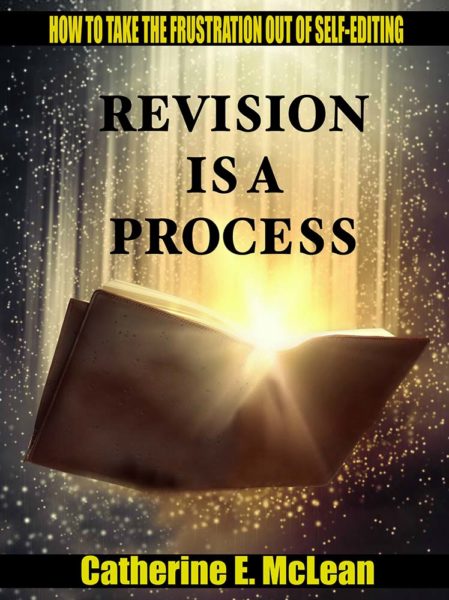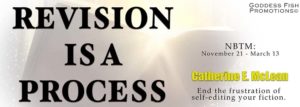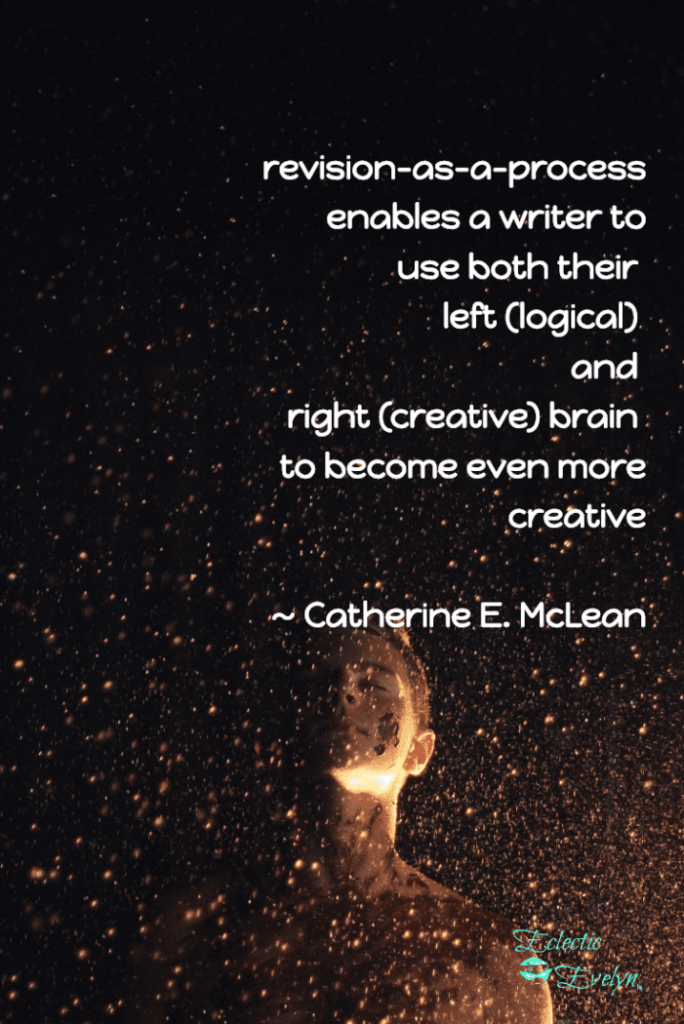Revision is a Process
How to Take the Frustration Out of Self-Editing
by Catherine E. McLean
A first draft holds the possibility of what will be a great story. Revision turns that rough diamond into a spectacular gem worth a reader’s money and time.

Writers are individuals but to be a producing writer means creating a system to revise and polish a work so the reader thoroughly enjoys the story. REVISION IS A PROCESS is a guidebook for writers and authors that shows how a simple 12-step process can be tailored to eliminate the most common and chronic maladies of writing genre fiction. This valuable guidebook contains secrets, tips, practical advice, how-to’s, and why-to’s for taking the frustration out of self-editing.
From Section 9 – Said is not Dead
One of the most controversial aspects of writing dialogue is the use of said as a speech tag. Some think using said is pedestrian and boring, others pepper every line of dialogue with said for fear the reader won’t know who is speaking. The fact is that said is nearly invisible to a reader. However, overuse is a common problem, so delete as many as possible without jeopardizing clarity or use beats. (Revisit the Oubliette example on the previous page. Said was not used. Beats were.)
In your review to minimize using said, watch for LY or ING ending speech tags like: “Drop dead,” she said dramatically. That tells (and does so poorly). Instead, show with a beat: “Drop dead.” The anger in her voice was unmistakable. You should avoid such tags as “Of course,” he said knowingly (which has an ING and an LY). You may catch the LY and ING tags in the passivity check, which is discussed in Section 11. However, don’t mistake the ING words when they’re necessary, such as “Oh, that dialogue speech tag has a participle added to it,” Marsha said, squinting at the underlined word on the page.
Yes, that’s right, squinting is part of a participle phrase, which can be useful in speech tags.
Purchase REVISION IS A PROCESS at Amazon or Barnes & Noble
Author Bio

Catherine E. McLean‘s lighthearted, short stories have appeared in hardcover and online anthologies and magazines. Her books include JEWELS OF THE SKY, KARMA & MAYHEM, HEARTS AKILTER, and ADRADA TO ZOOL (a short story anthology). She lives on a farm nestled in the foothills of the Allegheny Mountains of Western Pennsylvania. In the quiet of the countryside, she writes lighthearted tales of phantasy realms and stardust worlds (fantasy, futuristic, and paranormal) with romance and adventure. She is also a writing instructor and workshop speaker. Her nonfiction book for writers is REVISION IS A PROCESS – HOW TO TAKE THE FRUSTRATION OUT OF SELF-EDITING.
● Linked-In
Read a post written by Catherine E. McLean for Eclectic Evelyn Here and learn about her writing space and her office minions.

[contentblock id=8 img=gcb.png]






This sounds like a helpful book that will benefit many writers. Thanks for sharing.
Hi, James, thanks for stopping by today.
Reviewers have said that Revision is a Process is “an excellent tool for a writer” and that it offers a “simple, direct road map to revising” a project. I have received many reviews that never were posted to Amazon.com and have added them here at http://www.writerscheatsheets.com/reviews-for-revision-is-a-process.html
Again, thanks for your comment and I wish you all the best with your writing.
Thanks for hosting!
Thank you, Evelyn, for having me as your guest today and for featuring my book, Revision is a Process. I will stop by from time to time to day and look forward to chatting with visitors or answering their questions.
Thank you for writing the wonderful guest post about your writing space.
Hi, Evelyn, it’s always nice to share more than just the writing! Enjoy your day.
I use beats whenever possible but usually have to include several “said” tags for clarity. Have you found a ratio of the number of “said” uses per words in a story that works for you, or do you just use “said” when absolutely necessary?
Hi, Janet,
In the draft stage, I usually have way too many “saids” because it’s the ‘quick fix’ that doesn’t require stopping to figure out the best beat to use. When I do the revision round to look for “said,” I usually swap the word out for beats and to clarify the emotional state or bolster the action or drama going on. And, yes, a fewest possible saids will remain because nothing else will do at that point in the story.
As to your ratio question – I don’t think it’s possible to narrow it down to ‘saids per words’ because all depends on the narration and how much dialogue is used in a story.
I enjoyed the post, thank you.
Thank you, Rita, for letting me know you found the post interesting. I wish you all the best with your writing.
Thanks for sharing the excerpt!
Good luck with your book tour. This looks like a fun read. I hope that I win.
Hi, Bernie, glad you stopped by and I wish you much luck in winning the raffle.
The day draws to a close and I want to thank my hose, Evelyn, for featuring Revision is a Process and the post on my office space. I also thank everyone who commented and wish each and every one of you success with all your writing endeavors. Goodnight and God Bless.
Thank you for answering all the questions posted today and for writing such a useful book for all of us that are writers.
Thank you!
Good Morning, Happy Saturday! Hope it’s a fun day for you and that you also get time to yourself to relax and get “me” time. Thanks for all the hard work you do bringing us this great giveaway.